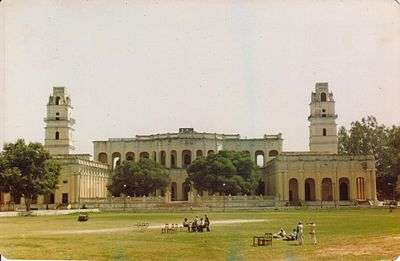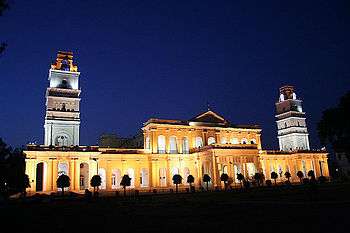Government Mohindra College
Established in 1875, Government Mohindra College Patiala, Punjab, India is the oldest institution of contemporary higher learning in Northern India.
| Type | College |
|---|---|
| Established | 1875 |
| Affiliation | Punjabi University |
| Principal | Dr Sangeeta Handa |
Academic staff | 112+ |
| Location | , , India |
| Campus | Urban, 21 acres/ 8.5 ha |
| Website | govtmohindracollege |

Mohindra College was the first institution in Punjab to receive A+ grade from the National Assessment and Accreditation Council (NAAC) of the Government of India. It has been ranked as number one college in India by the National Assessment and Accreditation Council (NAAC) in 2016 with highest CGPA of 3.86 which is highest in college section in India. The college offers undergraduate and graduate level education in basic sciences, political science, languages, history, public administration, commerce, computer applications, law, agriculture science, biotechnology,and clinical diagnostics.
Faculties
- Faculty of Arts: 22 departments
Campus
The 21-acre (85,000 m2) Mohindra College campus is outside the Patiala walled city opposite the National Institute of Sports, Patiala.
The college facilities include the Central Library, the Computer Center, the Health Center, the girls hostel, an auditorium with a seating capacity of 600, a botanical garden and elaborate sports infrastructure, particularly for cricket and swimming.
History
Then Viceroy of India Lord Northbrook laid the foundation stone for the main building of the college in 1875. It was named after Maharaja Mahendra Singh of Patiala, (also spelled as Mohindar Singh) when he died suddenly in 1876. Mohindra College was initially affiliated to the University of Calcutta; at the time, Calcutta was the capital of British Raj.
In 1882 the University of Punjab was established in Lahore, and Mohindra College became one of its first affiliated colleges. Following the partition of India in 1947, the college came under purview of the Punjab University, Chandigarh and, in 1962, under the Punjabi University of Patiala.
Principals

- Shri Joginder Nath Mukerjee 1881 to 1886
- Shri Dwarka Das 1886 to 1888
- Shri Atul Krishna Ghosh 1888 to 1906
- Shri E. Candler 1906 to 1915 (a novelist and travel writer)
- Shri T.L. Vaswani 1915 to 1919
- Shri Manmohan 1919 to 1921
- Shri A.K. Sharma 1921 to 1927
- Shri Vishwa Nath 1927 to 1927
- Shri B.N. Khosla 1927 to 1945
- Shri H.K. Bhattacharya 1945 to 1949
- Shri Teja Singh 1949 to 1952 (an eminent scholar and writer)
- Dr. Hardit Singh Dhillon 1952 to 1953
- Shri A.R. Khanna 1953 to 1957
- Shri K.L. Malhotra 1957 to 1958
- Dr. G.L. Bakhshi 1958 to 1962
- Shri M.L. Khosla 1962 to 1967
- Dr. Bhagat Singh 1967 to 1972
- Shri Gursewak Singh 1972 to 1976 (great sportsperson and educationist)
- Shri Umrao Singh 1976 to 1977
- Shri Harbakhsh Singh 1980 to 1982
- Dr. Jogindar Singh 1982 to 1987
- Dr. Gian Singh Mann 1987 to 1988
- Dr. Ujagar Singh Banga 1988 to 1989
- Shri Sarvjit Singh Gill 1989 to 1989
- Shri Parkash Singh 1991 to 1991
- Shri Mukhtiar Singh 1992 to 1996
- Shri Parminder Singh Sidhu 1996 to 1996 June
- Dr. S.K. Sarad 1996 to 1997 September
- Shri M.M. Singh 2000 to 2000 May
- Shri Sarwan Singh Chohan 2000 to 2000 October
- Dr. Vidwan Singh Soni 2000 to 2001 October (an eminent physicist, prehistorian & a popular science writer)
- Dr. Raj Kumar Sharma 2001 to 2005 April
- Dr. Daljit Inder Singh Brar May 2005 to July 2009
- Dr. Sudeep Bhangoo 12 August 2009 to February 2011
- Dr. Roopa Saini March 2011 to November 2012 (World cup gold medalist and Arjuna Award winner)
- Dr. Sukhbir Singh Thind November 2012 to July 2017
- Dr. Sangeeta Handa July 2017 to till date.
Shri Atul Krishna Ghosh was the longest serving Principal and instrumental in most of the early development works of this college. He was MA, Esq in English and was Professor of English with high credential. To make way for his British successor E Candler who was a journalist basically and was based in Bengal then and also his life was in danger from revolutionaries, Sri Ghosh was transferred to Muir College, Allahabad. He spent his last phase of his life in Allahabad in the company of Sri Motilal Nehru and Sri Madan Mohan Malaviya silently working for the freedom movement of India. The matter regarding his super-cession in Mohindra College, Patiala by Candler was even raised in British Parliament then, the transcript of which is preserved in British Library archive. He wrote several books and commentaries but because of later days association with the freedom movement, Britishers underplayed, suppressed and destroyed his records of achievements. He was great educationist and in those days appointed from Indian Education Service.
("Shri" is a term used in India as a title of respect.)
Funding
Mohindra College is funded by the Punjab Government and the University Grants Commission (India) while the campus is maintained by the Public Works Department of the State Government.
The college offers financial assistance to the economically disadvantaged sections of society. Undergraduate tuition is exempt for girls.
Women represent over half of the 200 member faculty while about a third of the faculty holds doctoral and post-doctoral credentials.
Trivia
A commemorative postage stamp on Mohindra College, Patiala was issued by the Government of India on 14 March 1988.
Principal from 1910 to 1914, Edmund Candler was also a noted novelist and travel writer. His novels Siri Ram: Revolutionist and Abdication are set partly in a college in the fictional town of Gandeshwar, which is probably based on Mohindra College.